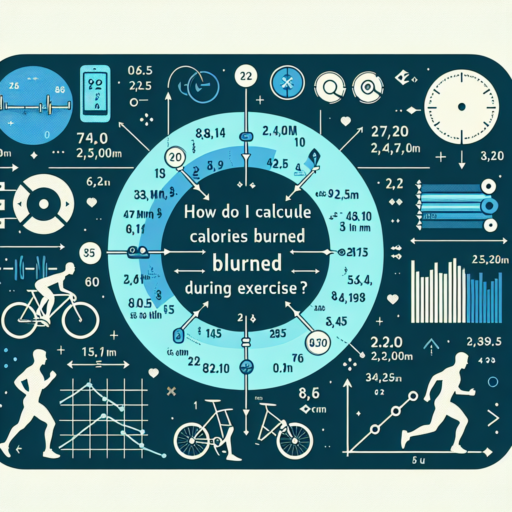Understanding the Relationship Between Heart Rate and Calorie Burning
Exploring the intricate relationship between heart rate and calorie burning offers invaluable insights into the effectiveness of workout regimes. Essentially, the heart rate serves as a pivotal indicator of metabolic activity – the faster your heart beats, the more calories you’re likely to burn. This is because an elevated heart rate signifies an increased demand for energy, driving the body to burn more calories to fuel its activities.
The connection hinges on the fact that exercise intensity directly influences both calorie expenditure and heart rate. High-intensity activities, such as sprinting or high-intensity interval training (HIIT), can dramatically increase heart rate. This surge not only enhances cardiovascular fitness but also maximizes calorie burning. It is the body’s adaptive response to the higher demand for oxygen and energy, turning to stored fats and carbohydrates for fuel, which in turn, is marked by an increase in calorie expenditure.
Understanding this relationship can be crucial for optimizing workouts based on individual fitness goals. For weight loss or improving cardiovascular health, monitoring heart rate can ensure exercises are performed at the right intensity to maximize fat burning. Technologies like heart rate monitors or smartwatches aid in precisely tracking heart rate zones during exercises, providing real-time feedback to adjust the intensity for optimal calorie burning.
How to Calculate Calories Burned Through Heart Rate
Calculating the calories you burn through heart rate during physical activity can provide a more personalized insight into your workout performance and efficiency. The process involves understanding your heart rate zones and how they correlate with calorie expenditure. While fitness trackers and heart rate monitors simplify this process, knowing the basics behind the calculation can be incredibly empowering.
To begin with, it’s essential to calculate your maximum heart rate, which can be estimated by subtracting your age from 220. This figure serves as a benchmark for determining your workout intensity levels. For instance, exercising at 70-85% of your maximum heart rate is generally considered to be in the cardio zone, a level at which you burn more calories, especially from fat.
Understanding Heart Rate Zones
Heart rate zones vary from person to person and indicate different levels of exercise intensity:
- Light Intensity: 50-60% of maximum heart rate
- Moderate Intensity: 60-70% of maximum heart rate
- Vigorous Intensity: 70-85% of maximum heart rate
By targeting specific heart rate zones, you can optimize your workout for fat burning, endurance building, or high-intensity training.
The actual calculation of calories burned involves a formula that considers your heart rate, age, gender, and weight. Although various calculators and algorithms exist, a common equation for a general estimate is:
[ text{Calories Burned} = (text{Age Factor} + text{Weight Factor} + text{Heart Rate Factor} – text{Gender Factor}) times text{Time} / 4.184 ]
Where each «Factor» is a variable that differs between individuals and requires specific constants for accurate calculation.
Understanding these basics can significantly enhance how effectively you monitor your fitness progress and adjust your workout routines for optimum results.
The Role of Heart Rate Zones in Burning Calories
Understanding the role of heart rate zones in burning calories is crucial for anyone looking to optimize their physical fitness routine. Essentially, our bodies burn calories at different rates depending on the intensity of the exercise, which directly correlates to our heart rate zones. These zones range from low-intensity, which is ideal for fat burning, to high-intensity, which is more focused on improving cardiovascular endurance. By tailoring your workout to target specific heart rate zones, you can maximize calorie burn and achieve your fitness goals more efficiently.
Targeting Specific Heart Rate Zones involves knowing your maximum heart rate (MHR) and calculating the percentage ranges for each zone. For example, the fat-burning zone typically ranges from 50% to 70% of your MHR, whereas the aerobic or cardio zone is about 70% to 85%. Exercises targeting the fat-burning zone, such as brisk walking or light cycling, might burn fewer calories per minute compared to those in the cardio zone, like running or aerobics. However, they are more efficient at burning fat specifically.
Adapting Your Workout Regimen to focus on different heart rate zones can lead to significant improvements in both calorie burning and overall physical health. For instance, incorporating sessions aimed at the higher heart rate zones can increase your metabolic rate, leading to more calories burned even when at rest. This strategic variation in exercise intensity not only aids in weight loss but also enhances your cardiovascular system’s efficiency, making everyday activities easier and improving your quality of life.
No se han encontrado productos.
Average Calorie Burn Based on Different Heart Rate Zones
Understanding how different heart rate zones affect calorie burn is crucial for optimizing your workout regime. While the body’s metabolic rate is inherently personal and can vary widely, certain patterns in energy expenditure become evident when we examine these zones closely. Generally, the body burns calories at different rates depending on the intensity of the exercise, directly linked to our heart rate zones.
Heart Rate Zones and Calorie Expenditure: Typically, heart rate zones are divided into five categories, each corresponding to a specific percentage of your maximum heart rate (MHR). The higher the heart rate zone, the more intense the workout, and consequently, the higher the calorie burn. For example, activities that keep you in Zone 1 (50-60% of MHR) focus on fat burn at a slow rate, often referred to as the ‘fat-burning zone.’ In contrast, exercises that push you into Zone 4 (80-90% of MHR) or Zone 5 (>90% of MHR) significantly increase calorie burn and are labeled as ‘cardio’ or ‘peak’ zones.
The exact number of calories burned can be challenging to pinpoint due to varying factors like age, weight, and fitness level. However, exercising in Zone 3 (70-80% of MHR), commonly known as the ‘aerobic zone,’ strikes a balance, offering a substantial calorie burn that promotes cardiovascular health without the extreme exertion required by higher zones. This makes it a favored zone for sustained workout sessions.
Pairing heart rate monitoring with knowledge of these zones provides a personalized framework for understanding and optimizing calorie burn during exercise. By targeting specific zones, individuals can tailor their workouts to meet their fitness and weight loss goals more effectively, utilizing data-driven strategies for maximum efficiency.
Heart Rate Monitors: Essential Tools for Tracking Calorie Expenditure
Heart Rate Monitors are pivotal in the realm of fitness and health, offering an in-depth analysis of calorie expenditure. These devices not only track your heart rate but also use sophisticated algorithms to estimate the number of calories you burn in each workout session. This information is crucial for individuals aiming to manage their weight, improve cardiovascular health, or optimize their fitness routine. By providing real-time data, heart rate monitors allow users to adjust their exercise intensity on the fly, ensuring they stay within their targeted heart rate zones for fat burning or endurance training.
Moreover, with the advent of wearable technology, heart rate monitors have become more accessible and convenient. Modern devices range from chest straps to wristbands, each equipped with sensors that ensure accurate heart rate measurements. This versatility makes it easy for users to find a heart rate monitor that fits their lifestyle and workout preferences. Whether engaged in running, cycling, swimming, or a high-intensity interval training (HIIT) session, these tools offer valuable insights into your physical activity and energy expenditure.
Integrating heart rate monitors into your fitness regimen can significantly enhance workout efficiency. By monitoring your heart rate, you can ensure that you are not overexerting yourself or undertraining. This delicate balance is key to reaching fitness goals, whether you’re aiming to shed a few pounds or preparing for a marathon. In addition, many heart rate monitors come equipped with features like workout summaries, training logs, and even guided workouts, adding an extra layer of support to your fitness journey.
Maximizing Your Calorie Burn: Tips for Optimizing Your Heart Rate
When aiming to maximize calorie burn, understanding the crucial role of your heart rate is essential. The right heart rate zone not only optimizes the calories you burn but also ensures that your workout aligns with your fitness goals, whether it’s fat loss, improving cardiovascular fitness, or enhancing stamina. This zone varies from person to person and can dramatically influence the effectiveness of your workout regimen.
One method to optimize your heart rate for maximum calorie burn is through High-Intensity Interval Training (HIIT). HIIT involves short bursts of intense exercise followed by periods of rest or lower-intensity exercise. This method is highly effective because it pushes your heart rate up, ensuring that you burn a significant number of calories in a short time, and elevates your metabolism for hours after your workout.
Another tool for maximizing calorie expenditure is heart rate monitoring. Whether using a fitness tracker or a sports watch, monitoring your heart rate in real-time can guide you to stay within your ideal fat-burning zone. This real-time data allows for fine-tuning of your workout intensity on the fly, ensuring that you’re not overexerting or undertraining, thus maximizing calorie burn efficiently.
Difference in Calorie Burning for Fat Loss vs. Cardio Training
When it comes to weight loss and improving fitness, understanding the difference in calorie burning between fat loss exercises and cardio training is essential. Although both exercise methods aim at enhancing health and fitness, their approaches and impacts on calorie expenditure differ significantly.
Intensity and Duration Impact
One key difference lies in the intensity and duration of the exercises. Cardio training, known for its high-intensity and shorter duration, focuses on elevating heart rates to burn calories quickly. In contrast, fat loss exercises often involve lower intensity but longer duration activities, aimed at maintaining a steady fat burn rate over a more extended period. This difference in approach can influence not only the number of calories burnt but also the source of calories used.
Metabolic Afterburn Effect
Another important aspect to consider is the metabolic afterburn effect, also known as Excess Post-exercise Oxygen Consumption (EPOC). Studies suggest that high-intensity cardio training can lead to a more significant afterburn effect, where the body continues to burn calories even after the workout is completed. Meanwhile, fat loss exercises, with their focus on steady, prolonged activity, may not evoke a similar level of EPOC, potentially leading to differences in total calorie expenditure post-exercise.
Frequently Asked Questions About Heart Rate and Calorie Burning
When it comes to understanding the relation between heart rate and calorie burning, several questions frequently arise. As individuals strive to optimize their fitness routines, grasping the intricacies of how one’s heart rate influences calorie expenditure is essential. This section aims to address some of the common queries surrounding this topic, offering insights that can help in personalizing workout strategies for better results.
How Does Heart Rate Affect Calorie Burning?
Heart rate is a critical indicator of the intensity level of a workout and directly impacts the number of calories burned. The higher the heart rate, the more calories one tends to burn. This is because as heart rate increases, the body requires more energy to sustain activity, thus tapping into stored fat and carbohydrates for fuel. Monitoring heart rate during exercise can therefore enhance the efficiency of workouts by ensuring they are performed at optimal intensity levels for calorie burning.
Is There an Ideal Heart Rate Zone for Maximizing Calorie Burning?
Yes, the concept of a ‘fat-burning zone’ suggests that there is an ideal heart rate range for maximizing calorie burning, typically between 60% and 80% of one’s maximum heart rate. Working out within this zone is believed to burn more fat in proportion to carbohydrates. However, it’s essential to note that higher intensity workouts, even if less time is spent in the ‘fat-burning zone,’ can result in a greater total calorie burn due to elevated post-exercise metabolism.
Understanding the dynamics of heart rate and calorie burning can significantly influence the effectiveness of your fitness regime. By incorporating heart rate monitoring into your workouts, you can unlock personalized insights that guide you towards achieving your fitness and weight loss goals more efficiently.
Real-Life Success Stories: Calorie Burning Aligned with Heart Rate Monitoring
Exploring the transformative journey of individuals who have achieved remarkable weight loss and fitness milestones, a common thread that stands out is the strategic alignment of calorie burning with heart rate monitoring. This method is not just a fad; it’s a scientifically backed approach that has propelled many towards their goals. By understanding the intricate relationship between the intensity of exercise and the heart rate, these enthusiasts have unlocked a more efficient pathway to shedding pounds and enhancing cardiovascular health.
Heart rate monitoring serves as a pivotal tool in this process, providing immediate feedback on the body’s response to different levels of physical activity. This data is crucial for optimizing workouts, ensuring that individuals are exercising within their target heart rate zones to maximize calorie burn. Success stories often highlight the importance of this method, elevating the relevance of personalized fitness plans that take into account each individual’s unique heart rate zones and caloric needs.
Amid these narratives, a recurring theme is the empowerment and motivation derived from witnessing tangible results. By meticulously aligning their fitness routines with heart rate data, people have not only accelerated their weight loss journey but also fostered a deeper connection with their physical wellbeing. This strategy illuminates the path for others aiming to embark on a similar journey, underscoring the pivotal role of embracing a methodical and informed approach to fitness.
Integrating Heart Rate-Centric Workouts into Your Fitness Routine for Maximum Calorie Burn
Integrating heart rate-centric workouts into your fitness routine presents an effective strategy for those aiming to optimize their calorie burn. By focusing on your heart rate, you can adjust your exercise intensity to remain within specific heart rate zones. These zones are pivotal for maximizing fat loss while improving cardiovascular health.
To begin with, understanding the different heart rate zones is essential. These zones range from very light activity levels, aiming to improve basic endurance and recovery, to maximum effort levels which increase speed and performance. For maximum calorie burn, the key is to spend substantial time in the aerobic zone. This zone typically allows for a consistent and prolonged workout intensity that maximizes fat burning.
Implementing heart rate-centric workouts requires wearing a heart rate monitor during exercise. This tool helps in identifying the exact heart rate zone you are currently in, allowing for real-time adjustments in workout intensity. Regular monitoring ensures that you are exercising at an optimal pace to ignite substantial calorie burn without overexerting yourself.
It’s important to gradually integrate these workouts into your routine. Begin by incorporating heart rate monitoring into your current exercises, progressively adjusting intensity levels to target different heart rate zones. Over time, you’ll notice improvements not only in calorie burn but also in endurance, strength, and overall fitness.




